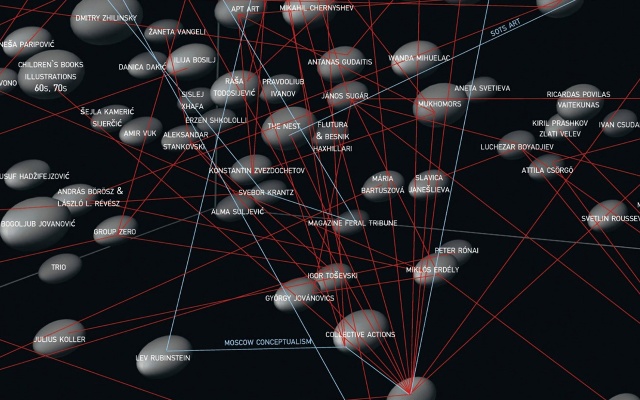The global contemporary art industry consists of (and constantly produces) an enormous number of professional networks and institutional systems. We have a growing number of biennials that feed on professionals; the ramified infrastructure of the art schools trains other pros, fresh and new, and the residencies network them; and other interconnected systems of these institutional organisms – the global web x.0.

East Art Map. Kolekty IRWIN.
Attempts to present the global art system in the form of clusters of dispersed networks has gained specific relevance with the spread of Latour's actor-network theory. (One of the first attempts to research, contextualize, and illustrate this structure of networked connections between the art scenes of Eastern Europe was the “East Art Map” project by the IRWIN group from Slovenia). The particular interest here is in paying attention to the actors whose strategies are not simply following guidelines and navigating themselves towards conquering top-nodes in the network, but rather to critically operate inside this structure like hackers do, searching for holes, gaps, leaks, shortcuts, and exceptions and thereby through these acts pervert the dynamics of power.
Decision-making mechanisms in the aforementioned institutions (biennials, residencies, etc.), as in many corporations, oftentimes are in the hands of all kinds of boards. This creates a pyramid of gatekeepers that carefully select participants and test them for compliance with institutional expectations and “professional standards.” It’s sanctions and sanctionability that has created a “new professionalism” in the art industry, which normalizes both art that produces and displays, and the discourses around it. As gatekeepers are interested in predictability and control, the critical wing of intellectuals is stimulated into testing the limits of the opposite qualities – being unpredictable, acting unnoticed, turning into a proxy-werewolf confusing the system. We need solidarity instead of competition, hospitality instead of selection, openness instead of control. Hereafter I would like to focus on the examples where either an institution was “hacked” in a good way or the useful model of an institutional alternative was introduced and tested, and how the very idea of hacking resonated inside those spaces.
So, let’s start with examples of gaps in-between the institutional structures, grey zones of invisibility and uncontrollability, that had reified in autonomous rooms or spaces created by artists.
Radio Hopes and Dreams
What if we push the institution into facing a double delegation? How might this weaken the potential control?
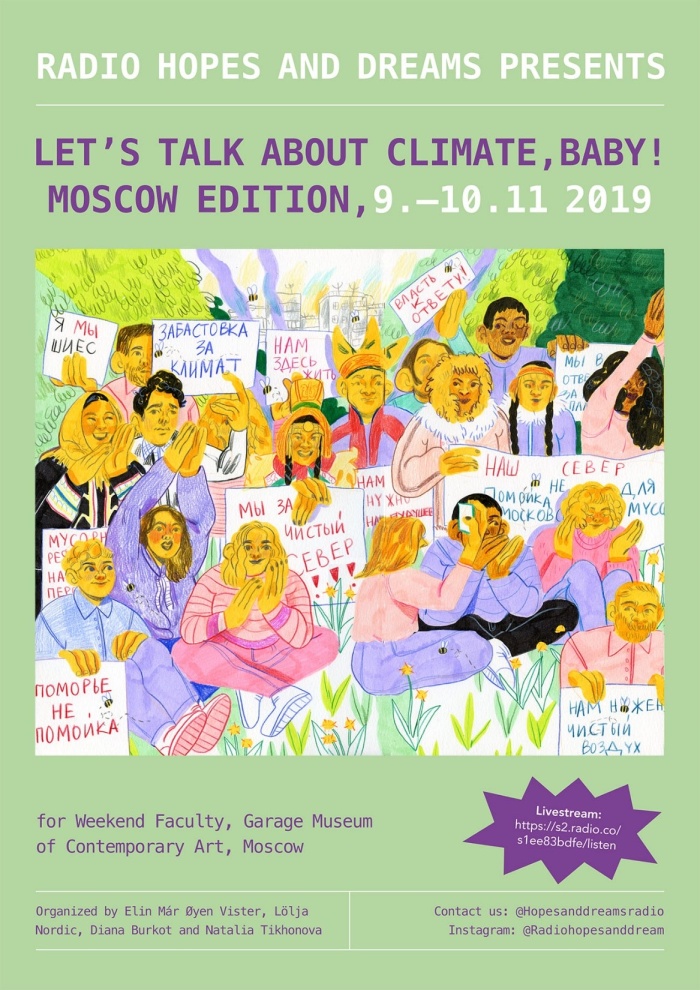
Plakat programu radiowego. Grafika: Eleni Koumi. Projekt plakatu: @anneolsendesign
For her contribution to the “Coming World: Ecology as the New Politics 2030–2100” exhibition in Garage MCA in Moscow, an artist from Norway – Elin Már – invited three local artists (Diana Burkot, Lölja Nordic, and Natalia Tikhonova) to collaborate on a two-day long radio platform, situated in a small separate room inside the museum. They decided to fill the program of “Radio Hopes and Dreams” with contributions from Russian artists, poets, politicians, activists, ecologists, including those who are involved in the most intense confrontation with authorities over a trash landfill in the North. Visitors were able to come into the studio, as well as listen to and take part in conversations and debates. The situation when one person is delegating decisions concerning the content of another, who in their turn invites other speakers and leaves enough room for spontaneity and unplanned contributions, allows participants to escape constant control and the need for approval. This thereby creates a situation where some views and positions are heard publicly, which wouldn’t have been possible otherwise.
Iceberg 18010813. Blue room
The Blue Room was created within the framework of platform blind_spot in 2018. In her project, Katya Ev created a zone of total anonymity – a chamber in the center of a megapolis. The visitor agrees to access the room and can book it only by answering an advertisement on avito.ru (the Russian analog version of eBay). When someone visits, the room is opened and fully prepared to host the participant. The participant is informed that there is no surveillance and can lock the door from the inside to feel safe. Whenever a visitor decides to leave, they have to inform the artist that the room is has been vacated. The room is equipped with a freshly made bed ready to host the guest, with a melatonin pill and a glass of water on the bedside table and a table with a computer on the other side of the room. The computer was configured to have an unlimited access to the dark web, and equipped with a basic manual on how to use and get around on it. This provided the visitor with the possibility of making a pure ethical choice between safely accessing the darkest possible areas of human activities and, on the contrary, protecting himself from that knowledge by choosing to sleep deeply and using this experience of anonymous solitude to rest up. On the other hand, the blue room sharply resonated with political context of Moscow, which had recently implemented a law prohibiting the use of web anonymizers (VPNs).
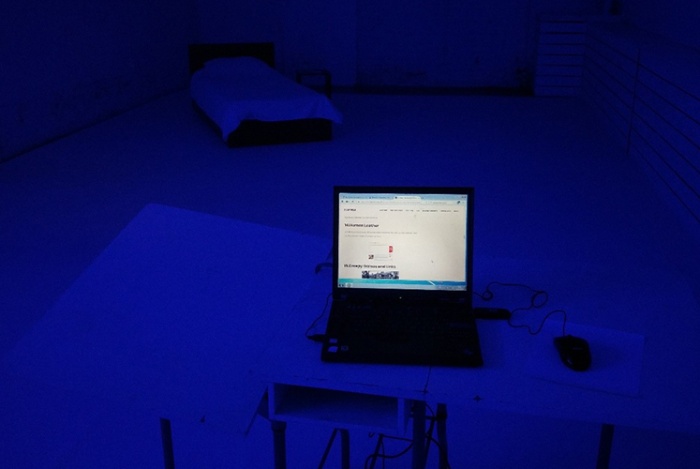
Iceberg 08130118. Blue room, Kattia Ev, 2018. Zdjęcie dzięki uprzejmości Katii Ev.
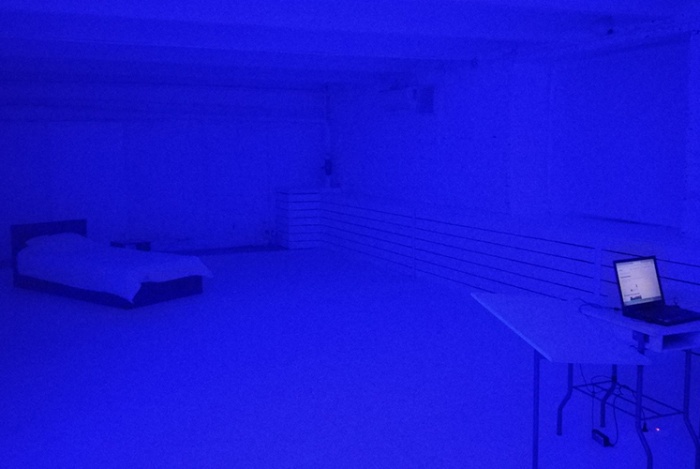
Iceberg 08130118. Blue room, Kattia Ev, 2018. Zdjęcie dzięki uprzejmości Katii Ev.

Plakat użyty w projekcie Blue Room.
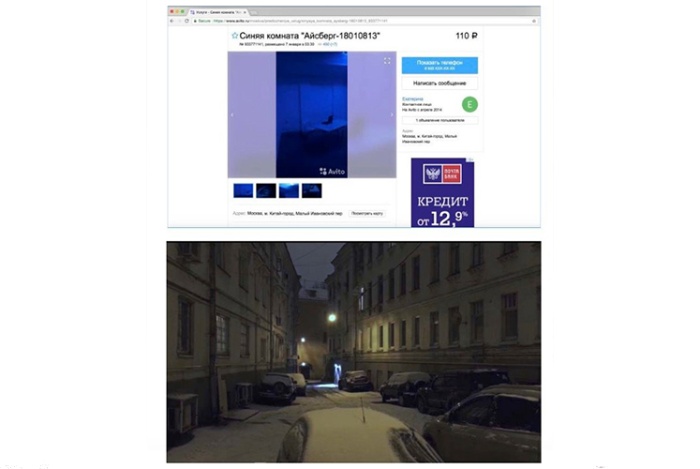
Zrzut ekranu strony z reklamą na Avito.ru, 2018. Dzięki uprzejmości Katii Ev.
Mystery covered with darkness
Another attitude of “providing space for people” one can find in the dark room – the “mystery covered with darkness” project by the eeefff duo (Nicolay Spesivtsev and Dzina Zhuk). During the residency “Camp As One,” artists turned one of the sanatorium rooms into a totally dark place and announced a call to explore this darkness. Artists collected requests via email and then instructed potential dark explorers through a “proxy whisper into ear” how to gain access to the room, what the rules are, and what time to go there. The visitors (called dark comers) were not allowed to turn on any lights or otherwise disrupt the darkness of the room nor to take photos or record their experience or talk about it afterwards, although everyone was allowed to stop and exit the room whenever (s)he felt like it. Supposedly, the dark comers would not recognize each other, facing anonymous encounters or distant voices and signals; it was also possible to book a visit for someone else.
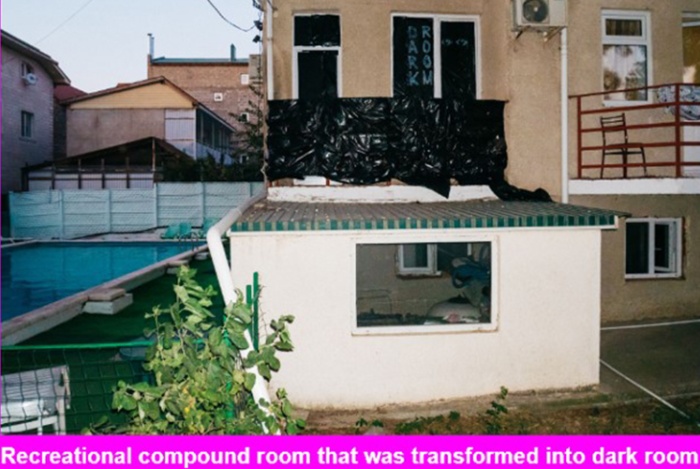
Mystery covered with darkness, widok pokoju z zewnątrz. Dzięki uprzejmości eeefff.
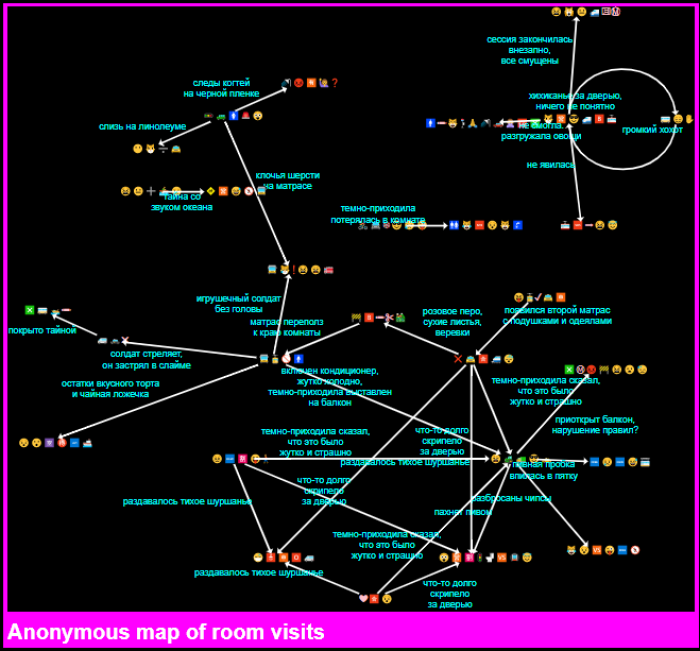
Mystery covered with darkness. Dzięki uprzejmości eeefff.
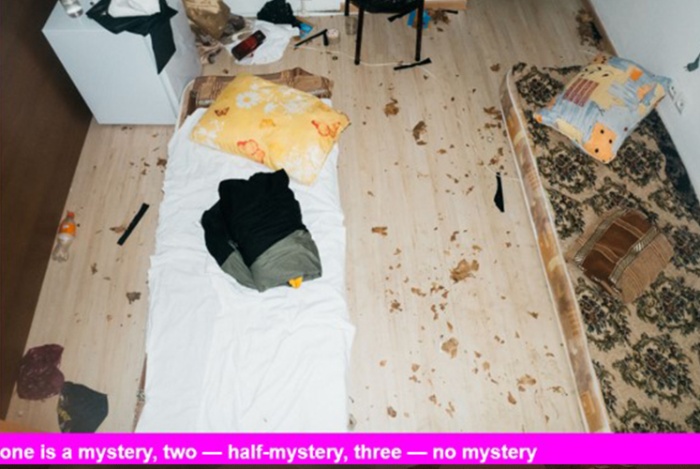
Mystery covered with darkness. Dzięki uprzejmości eeefff.
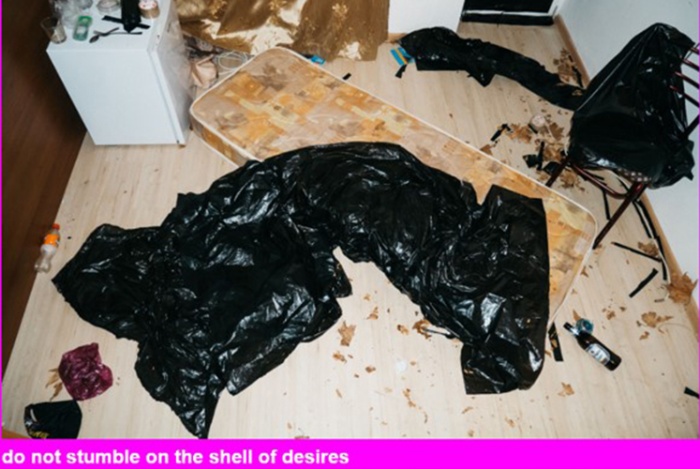
Mystery covered with darkness. Dzięki uprzejmości eeefff.
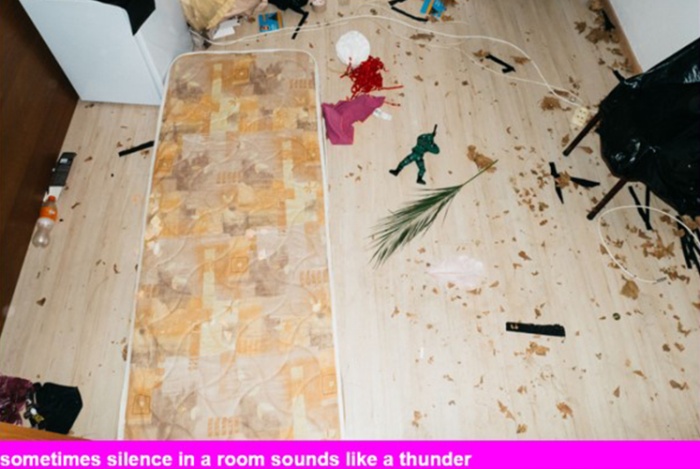
Mystery covered with darkness. Dzięki uprzejmości eeefff.
Unlike the work by Katya Ev, where potentially any person could enter the space and anonymously delve into a trip through different sorts of reality, the dark room, and “shady affairs” inside were accessible only for those who had already stayed in the sanatorium and, practically, were requested mostly by participants of the residency and a few sanatorium workers. In these circumstances, guessing the personality of a fellow “dark partner” becomes a part of the game, where darkness and mystery (somewhere between wonder and uncanny) works as a poetic tool in a playful setting.
Camp As One
That situation was possible in a community of people who trusted each other and shared certain values and had views in common – so they could comfortably feel like conspirators. The two following examples are cases of grassroot initiatives which function as a spider web (or as with mycelium) connecting a wide community of artists/curators/theorists in the post-Soviet region. The aforementioned dark room took place as part of the Camp As One residency that was organized by curator Masha Kotlyachkova and philanthropist Diana Kazanchyan in the south of Russia, in a sanatorium belonging to the Kazanchyan family near the Black Sea coast. Participants were welcomed to spend a week of vacation together there and had to propose a “collective practice” for their time in the residency. Although the selection of the participants was proceeded by an open call, the vast majority of guests knew each other already. It’s important to consider the “medium” of conviviality and playfulness as one of the key factors in the functioning of such residencies. Projects during the residency should have been easy to carry out surrounded by the atmosphere of a vacation by the sea. At Camp As One, the focus on many works was self-reflexively placed on the residential situation for precarious artists (that despite a declared openness also included a selection procedure nonetheless), bodily experience in digital times, and inside a closely connected group of people (“digital hugs” by Sasha Puchkova), and social dynamics inside that community.
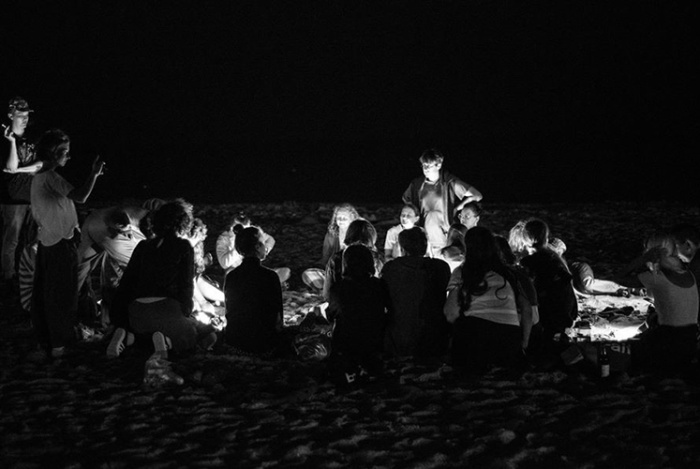
Reading practice z Tonym Trubitsiną. Dzięki uprzjemości Olyi Virich.
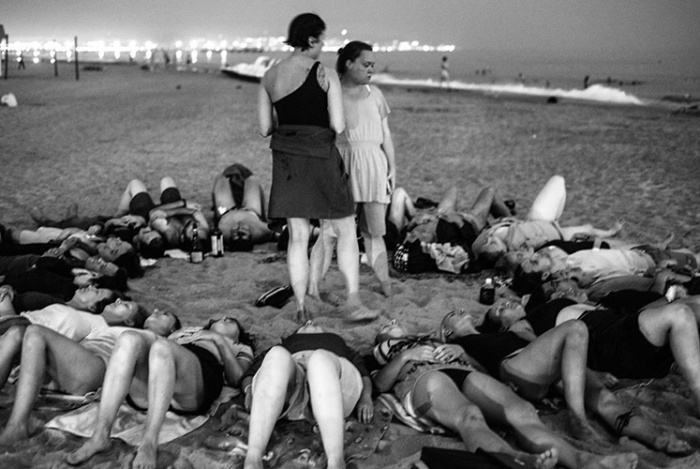
Cyfrowe uściski [Digital hugs] z Saszą Puczową. Dzięki uprzejmości: Olyi Virich.
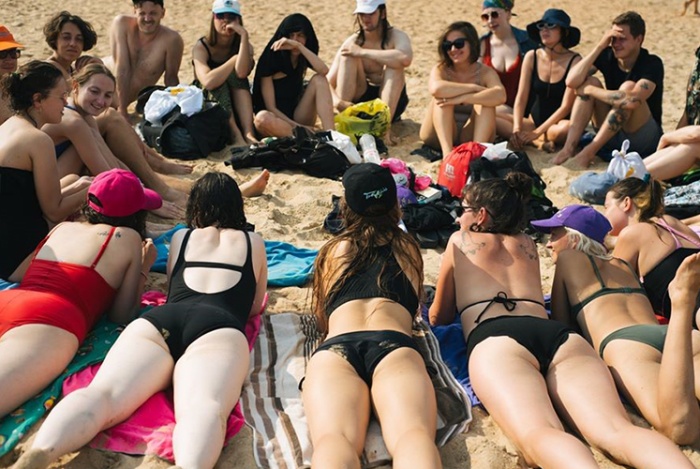
Camp as One 2019. Zdjęcie: Olya Virich.

Camp as One 2019. Zdjęcie: Olya Virich.
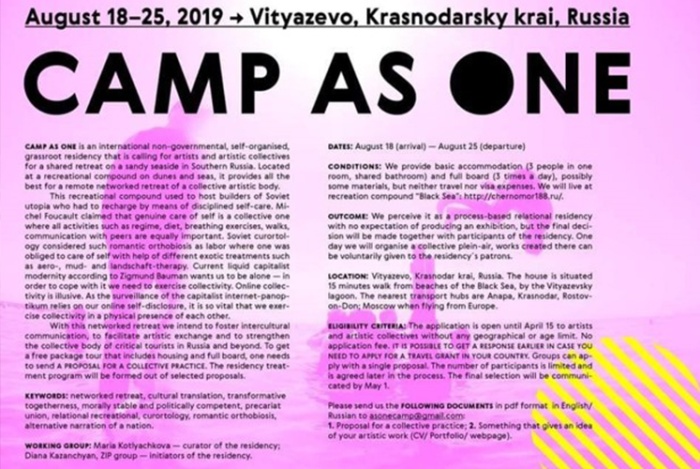
Ogłoszenie o otwartym naborze na Camp as One.
Work Hard! Play Hard!
A festival in Minsk, Belarus with a week-long intensive program was initiated and organized just by four people (artist duo eeefff [Dzina Zhuk, Nicolay Spesivtsev] and independent curators Aleksei Borisionok and Olia Sosnovskaya) with the altruistic help of their friends. The key factor that made the festival doable was the possibility of using friends’ homes for guests to stay. Based on pure enthusiasm and self-exploitation, Work Hard! Play Hard! raises the questions of knowledge production, cooperation, work, leisure, technology, and acceleration through various performative, participatory, and discursive formats. A close-to-zero-budget model dictates a specific attitude towards production, organization, and collectivity. Participants paid their own way, lived in the houses of “friends of friends,” and joined the joyful collective experiences. That makes this initiative totally self-coordinated and independent albeit self-exploiting but at the same time, paradoxically, relaxing. It engenders an institution that doesn’t need particular facilities but rather every year reconfigures itself anew and discovers places in city of Minsk and its surroundings that are not common. The events took place in different offsite spaces (such as Cantine XYZ, Drugi Paverh), artists’ studios, central city market, fitness clubs, and dance halls, Central State Library (that was used without prior permission) and, of course, on the city streets, interacting with the city’s milieu. The playful dynamics of events is used to explore and initiate gaps in the urban tissue and in local social conventions. The most recent two editions of WHPH also included several days in countryside sanatoriums (residues of Soviet heritage) – the working group of WHPH organized a booking of a dozen rooms and used the existing infrastructure of leisure zones as a playground for festival events (an attitude that was subsequently mirrored in Camp As One, basically). Such an initiative requires a degree of involvement that renders the audience meaningless as a category: in any project the visitor becomes a part of the community, and hence, the community coincides with the audience. The whole program and its situational existence of one intensive week out of the year demands that the community is flexible, not restricted by locations and borders, and insanely mobile – ready to be mobilized. General absence of certainty and predestination on all levels and radical flexibility, in case of WHPH, responds to the emblematic revolutionary call – “Be water!”
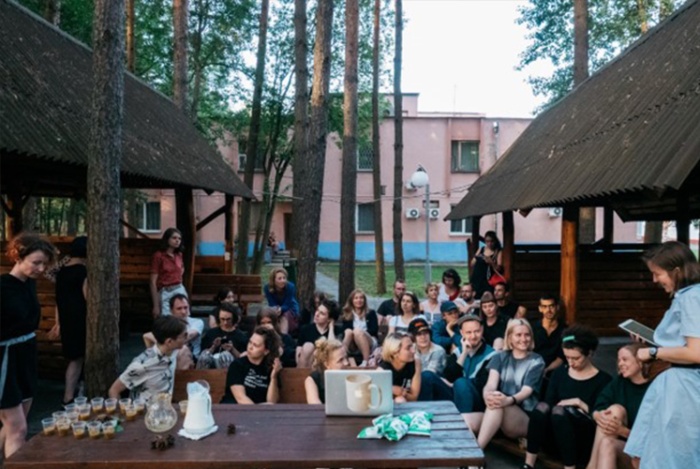
Masza Kotliaczkowa, Biobar “Tango of psychobiotics”. Zdjęcie dzięki uprzejmości Mikołaja Spesiwcewa.
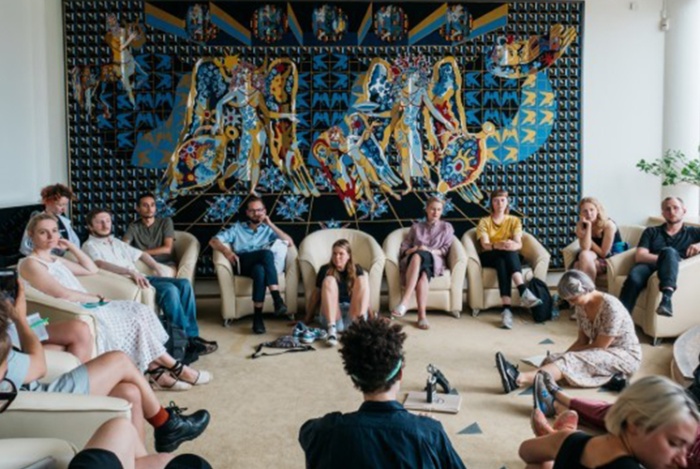
Cara Tolmie, Gender of Sound. Zdjęcie dzięki uprzejmości Mikołaja Spesiwcewa.
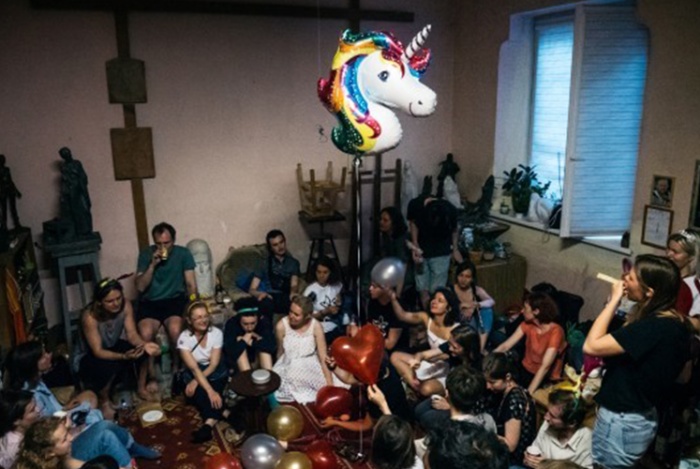
Apparatus 22 i Siergiej Kantsedal, Party-marathon «Positive Tension (on curating)». Zdjęcie dzięki uprzejmości Mikołaja Spesiwcewa.
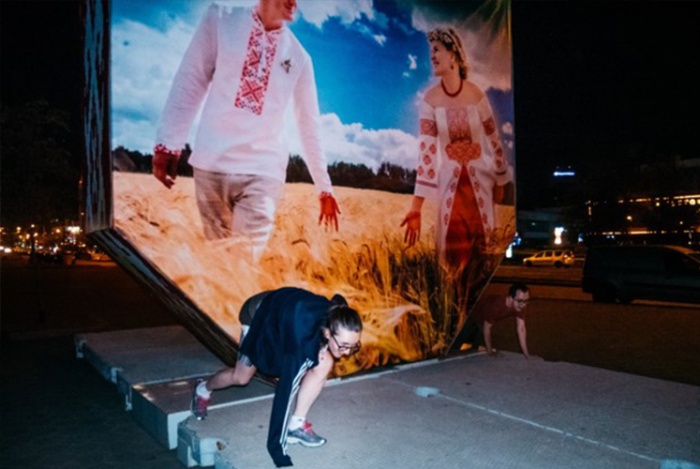
atom (Alisa Olewa and Timothy Maximenko), «a walk through». Zdjęcie dzięki uprzejmości Dziny Żuk.

Uliana Byczenkowa and Żanna Dolgowa, Welcome To The Dollhouse! (Catechism for the Mass on dresser (on physical medium!) Zdjęcie dzięki uprzjemości Mikołaja Spesiwcewa.
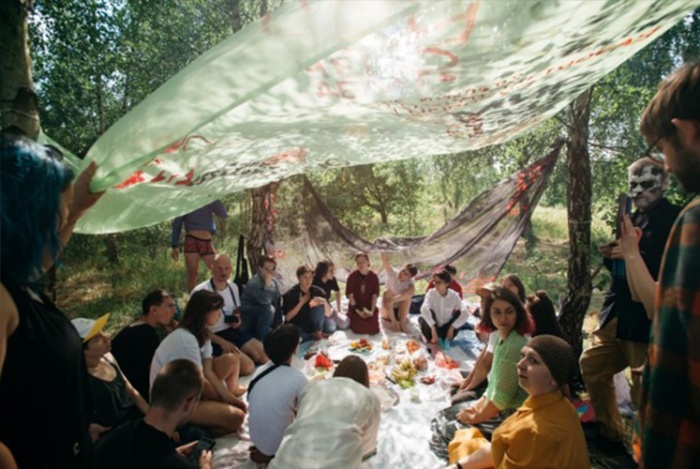
n i i c h e g o d e l a t (nothing-to-be-done scientific research institute), «Picnic without theory». Zdjęcie dzięki uprzejmości grupy warsztatowej Work Hard Party Hard 2019.
Salon of Idleness, and the network of bubbles in residencies
In contrast to the “act-hard” imperative (although ironic) of the title of the initiative described above, Salon was declared to be a place for idleness in Basel – the epicenter of protestant bourgeois culture of success, quality, order, and efficiency. The Salon of Idleness was integrated into Basel edition of platform blind_spot, which was a short-term, soft, and powerless institution that aimed to develop the values of passivity, weakness, subtlety, and deceleration through the means of contemporary art, cultural collectivism, mumblecore modality, and alternative economic relations. The crucial aspect and ethical aim of Salon was to destigmatize unproductivity and laziness, and to deliver for the Swiss audience a 24-hour open “aimless” space for gathering, a space open for everyone, a place where people can just stay and spend (or even waste) some of their time, where idleness was acknowledged rather than condemned so visitors could enjoy it without feeling any guilt. Located in the conventional exhibition hall, Salon totally reversed the protocols of work concerning a “professional site of display” – it had no particular “working” hours, no specific display except the comfortable but weird furniture setting (that constantly changed over time), and no predefined program – but it was inhabited with communities and long conversations, especially in the late evenings and nights.
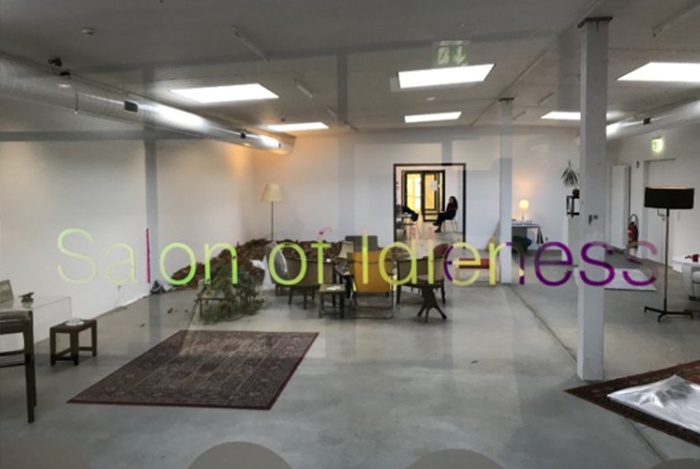
Salon Bezczynności [Salon of Idleness], widok z dn. 09.12.2018. Zdjęcie dzięki uprzejmości Iwana Isajewa.
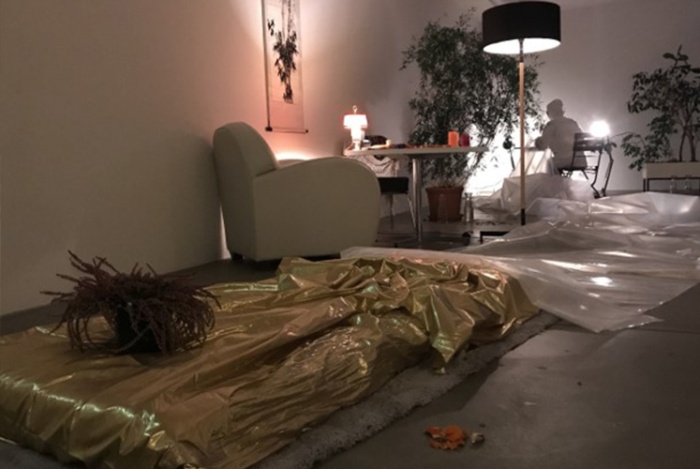
Salon Bezczynności [Salon of Idleness], widok z dn. 08.12.2018 ze złotym łożem lenistwa Anastazji Kizlowej. Zdjęcie dzięki uprzejmości Iwana Isajewa.
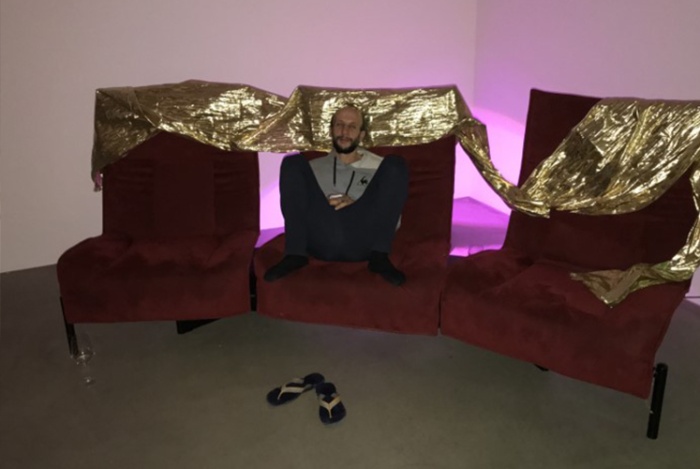
Petr Szirkowski w Salonie Bezczynności. Zdjęcie dzięki uprzejmości Iwana Isajewa.
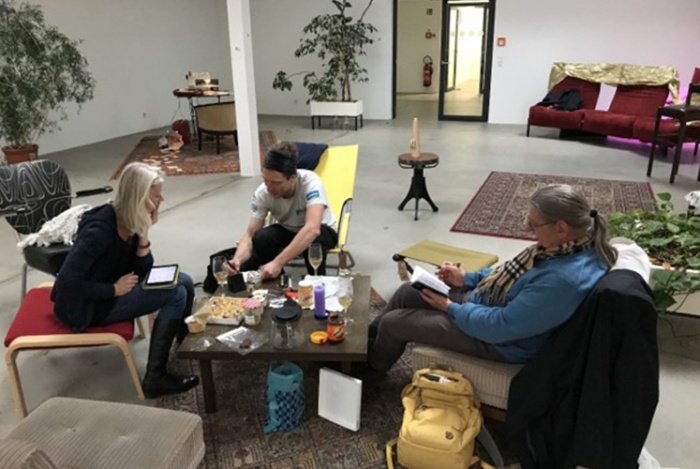
Zebranie zespołu NETZBON. Zdjęcie dzięki uprzejmości Iwana Isajewa.
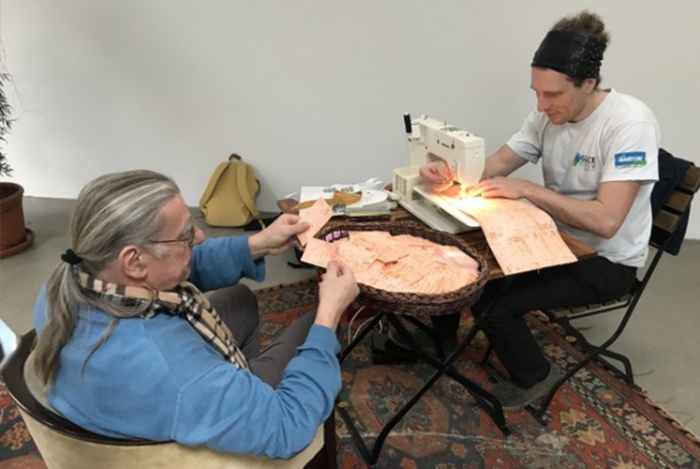
Zespół NETZBON pracujący przy maszynie do zszywania pieniędzy. Zdjęcie dzięki uprzejmości Iwana Isajewa.
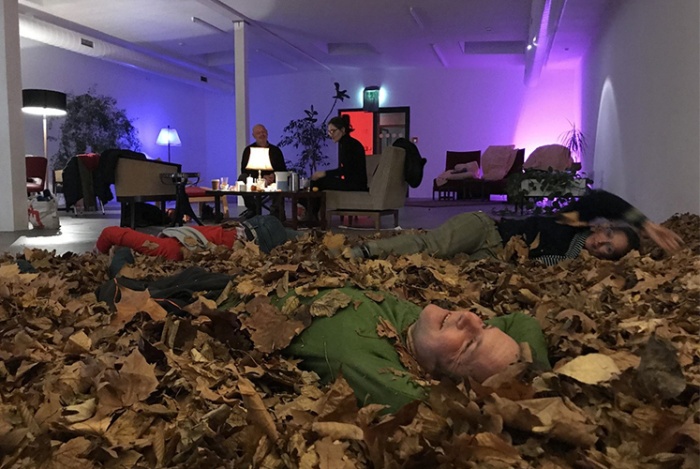
Salon Bezczynności [Salon of Idleness], widok z dn. 28.11.2018. Zdjęcie dzięki uprzejmości Iwana Isajewa.
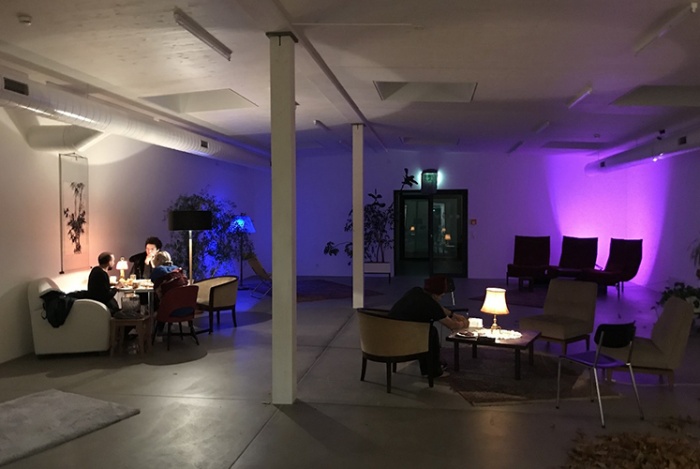
Salon Bezczynności [Salon of Idleness], widok z dn. 26.11.2018. Zdjęcie dzięki uprzejmości Iwana Isajewa.
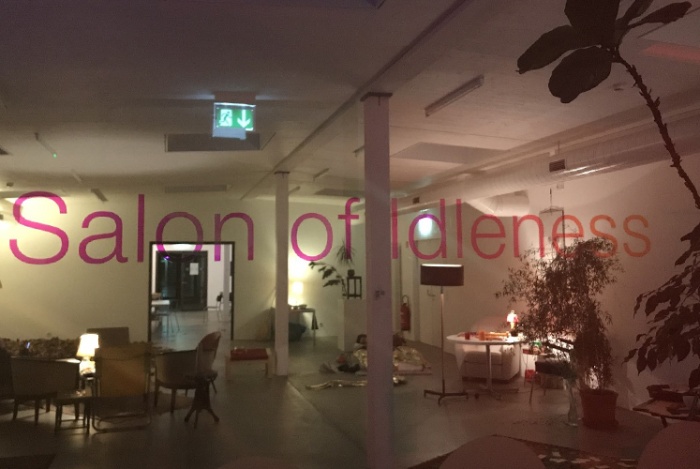
Salon Bezczynności [Salon of Idleness], widok z dn. 08.12.2018. Zdjęcie dzięki uprzejmości Iwana Isajewa.
Important to note that the fundament of the platform blind_spot is a specific set of ethical values, it is something that lays beyond the goals of the “professional” art institution that has to fulfill the quantitative plan/expectations of a certain number of events and visitors. Here, ethics is understood as a base for cultural and political change – as ethics works as software of politics. Changing the ethos, you are also reprogramming the political. However, how can the institution itself follow its own guidelines, be weak enough, and not produce hierarchies but erase them? At least, it shouldn’t control and guard its walls, and instead should welcome anyone who wants to enter. No one who wants to contribute to the platform should be rejected as long as their actions work towards the declared values. Everybody could voluntarily come and stay with us for an indefinite amount of time.
During the process of blind_spot, I stayed in the residency of Atelier Mondial, and we made an agreement with the residency team to occupy some temporarily empty rooms along with some guests of our platform (also our friend Nic Bezemer had kindly contributed his own studio for that purpose). Some of our guests stayed with us for almost two months, basically using all the facilities of the residency without being selected by the actual board of it. One may say that this “hacking of a residency” had created the double bubble of uncontrollability – both people and program don’t need to be approved by anyone, neither from the host’s side nor from the platform’s initiators.
*
Many independent initiatives existing on the wreckage of infrastructure and institutions. WHPH used leftovers of Soviet social infrastructures in the slowly gentrifying outskirts of Minsk. The sanatorium where Camp As One took place is on sale now so it is likely that this residency might not happen ever again. Here we come across the existence under the circumstances of radical instability. Parallel to the exploring of wreckages, there are flourishing institutional systems to exploit – like fancy international residencies or, in the case of Radio Hopes and Dreams, rich private institutions like Garage – and this might be a valid tactic as well. Radical plasticity and alacrity for mobilization helps the independent initiatives to take advantage of the situation. Can we create a community instead of an audience; test the limits of attention of institutions with tricks like double delegation; subvert the right of veto; create the rooms and bubbles of anonymity and uncontrollability and put ethics over the quantitative parameters and short-term goals?
What if we think about the tool, or a platform, that will help to find and organize these bubbles? At least, as a variety of residencies allow their residents to invite guests, it’s possible to create a network of solidarity and hospitality, an informational source where each participant can post about the possibility of hosting somebody, and other participants can react to it. This platform, working as an analog to couchsurfing, could bring a residency-surfing model with a wide circle of cultural workers who would have access to deficit resources without any approval from third parties including institutional gatekeepers. This may establish yet another connection between cultural workers on a global scale, a sophisticated and updated global web x.1, which works in a different modality and with different economics where it’s people who distribute and take the resources – in a network that is not easy to be represented or grasped – people who are uncatchable - inappreciable - unaccountable.
BIO
Ivan Isaev (*1986) – independent curator, based in Moscow. Curator-in-residency at Ausstellungsraum Klingental, Basel, 2018. Initiator of platform blind_spot (since 2017). Co-founder of «Triangle» curatorial studio (Moscow, 2014-2016). Participant of Infra-Curatorial Platform at 11th Shanghai Biennale (2016). Curator of platform Start, Winzavod, season 2014-15, and “Leaving Tomorrow” exhibition (2015, Moscow). Member of ICI (Independent Curators International).
* Cover photo: Fragment of East Art Map, IRWIN collective.



